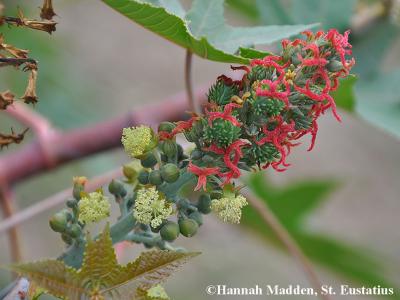(In territories with significant traditional TRAMIL use)
Dominican Republic:
- cebollín
Haiti:
- zechalot
bulb, decoction, taken orally,
bulb, juice with sugar (“syrup”), taken orally3
According to the information available:
The use for lung disease, cold and flu is classified as REC based on the significant traditional use documented in the TRAMIL surveys and the scientific information published.
If deterioration is observed in the patient or the symptoms persist for more than 7 days, seek medical attention.
Due to the health risk of lung disease, an initial medical
assessment is recommended. The use of this resource must be considered complementary to medical treatment, unless contraindicated.
It has been recommended that onions (Allium cepa) should only be used in limited quantities because they contain allyl sulfoxides and other related sulfoxides that inhibit enzymes with thiol groups4.
The use for sores (oral candidiasis) infections is classified as REC based on the significant traditional use documented in the TRAMIL surveys and the scientific information published.
All topical application must follow strict hygiene measures in order to prevent contamination or additional infection.
Not for use during pregnancy, breastfeeding or in children under 3 years.
The bulbs of Allium cepa var. cepa and Allium cepa var. aggregatum constitute a food of widespread human consumption.
For lung disease:
Chop up 1 to 3 bulbs, crush them in a mortar and squeeze them in a cloth or with a teaspoon moving it round in a hand sieve. Mix 1-2 spoonfuls (15 to 30 millilitres) of juice with bee honey. Take on an empty
stomach daily for 3 weeks.
For cold, flu:
prepare a decoction with 1 bulb in 2 cups (½ litre) of water, boil for 10 minutes in an covered vessel. Leave to cool, strain (filter) and drink 1 cup 3 times a day. Or prepare a “syrup” by cutting 1 bulb, mix 3 spoonfuls of
sugar, leave it to rest for several hours, filter with a cloth or a fine sieve and take one spoonful 3 times a day until the symptoms disappear.
For sores (candidiasis bucal):
chop up 100 grams of bulb and add to 2 cups (½ litre) of boiled water, leave to macerate for 12 hours and apply with a dropper or 5-millilitre teaspoon 3 times a day for 5 days.
Preparations must never be stored for more than 24 hours, even if refrigerated.
1 GERMOSÉN-ROBINEAU L, GERÓNIMO M, AMPARO C, 1984
Encuesta TRAMIL. enda-caribe, Santo Domingo, Rep. Dominicana.
2 WENIGER B, ROUZIER M, 1986
Enquête TRAMIL. Service Oecuménique d'Entraide SOE, Port au Prince, Haïti.
3 BOULOGNE I, 2009
Enquête TRAMIL, (Terre-de-Bas et Terre-de-Haut) Les Saintes, UAG, Guadeloupe (FWI).
4 AUGUST KT, 1996
Therapeutic values of onion (Allium cepa L.) and garlic (Allium sativum L.). Indian J of Experimental Biology 34(7):634-640.
5 BLOCK E, NAGANATHAN S, PUTMAN D, ZHAO SH, 1992
Allium chemistry: hplc analysis of thiosulfinates from onion, garlic, wild garlic (ramsoms), leek, scallion, shallot, elephant (great-headed) garlic, chive, and Chinese chive. Uniquely high allyl to methyl ratios in some garlic samples. J Agr Food Chem 40(12):2418-2430.
6 WU JB, CHENG YD, HUANG SC, CHANG KH, HSIEH MT, 1992
Quantitative determination of active compounds in Allium genus (Liliaceae) by hplc. China Med Coll J 1(2):123-128.
7 TOKITOMO Y, KOBAYASHI A, 1992
Isolation of the volatile components of fresh onion by thermal desorption cold trap capillary gas chromatography. Biosci Biotech Biochem 56(11):1865-1866.
8 DONNER H, GAO L, MAZZA G, 1997
Separation and characterization of simple and malonylated anthocyanins in red onions, Allium cepa L. Food Res Int 30(8):637-643.
9 FULEKI T, 1969
The anthocyanins of strawberry, rhubarb, radish and onion. J Food Sci 34(4):365-369.
10 PATIL BS, PIKE LM, YOO KS, 1995
Variation in the quercetin content in different colored onions (Allium cepa L.). J Amer Soc Hort Sci 120(6):909-913.
11 SHAMS-GHAHFAROKHI M, SHOKOOHAMIRI MR, AMIRRAJAB N, MOGHADASI B, GHAJARI A, ZEINI F, SADEGHI G, RAZZAGHI-ABYANEH M, 2006
In vitro antifungal activities of Allium cepa, Allium sativum and ketoconazole against some pathogenic yeasts and dermatophytes. Fitoterapia 77:321–323.
12 SRINIVASAN D, NATHAN S, SURESH T, PERUMALSAMY PL, 2001
Antimicrobial activity of certain Indian medicinal plants used in folkloric medicine. J Ethnopharmacol 74(3):217-220.
13 SHARMA KC, SHANMUGASUNDRAM SSK, 1979
Allium cepa as an antiasthmatic. RRL Jammu Newsletter 6(2):8.
14 DORSCH W, ETTL M, HEIN G, SCHEFTNER P, WEBER J, BAYER T, WAGNER H, 1987
Antiasthmatic effects of onion. Inhibition of platelet-activating factor-induced bronchial obstruction by onion oils. Int Arch Allergy Appl Immunol 82(3/4):535-536.
15 DORSCH W, ADAM O, WEBER J, ZIEGELTRUM T, 1985
Antiasthmatic effects of onion extracts -detection of benzyl- and other isothiocyanates (mustard oil) as antiasthmatic compounds of plant origin. Eur J Pharmacol 107(1):17-24.
16 DORSCH W, WAGNER H, 1991
New antiasthmatic drugs from traditional medicine? Int Arch Allergy Appl Immunol 94(1/2):262-265.
17 ROCKWELL P, RAW I, 1979
A mutagenic screening of various herbs spices and food additives. Nutrition and Cancer 1(4):10-16.
18 MAHMOUD II, ALKOFANI AS, ABDELAZIZ AA, 1992
Mutagenic and toxic activities of several spices and some Jordanian medicinal plants. Int J Pharmacog 30(2):81-85.
19 THOMSON M, ALNAQEEB MA, BORDIA T, AL-HASSAN JM, AFZAL M, ALI M, 1998
Effects of aqueous extract of onion on the liver and lung of rats. J Ethnopharmacol 61(2):91-99.
20 VERHOEFF J, HAJER R, VAN DEN INGH TS, 1985
Onion poisoning of young cattle. Vet Rec 117(19):497-498.
21 BEATTY ER, O'REILLY JD, ENGLAND TG, MCANLIS GT, YOUNG IS, GEISSLER CA, SANDERS TA, WISEMAN H, 2000
Effect of dietary quercetin on oxidative DNA damage in healthy human subjects. Br J Nutr 84(6):919-925.
22 GRUENWALD J, BRENDLER T, JAENICKE C, 2004
Physicians’ Desk Reference for Herbal Medicines, Third Edition. Montvale, NJ, USA: Thomson Healthcare, Inc. 988pp.
23 VALDIVIESO R, SUBIZA J, VARELA-LOSADA S, SUBIZA JL, NARGANES MJ, MARTINEZ-COCERA C, CABRERA M, 1994
Bronchial asthma, rhinoconjunctivitis, and contact dermatitis caused by onion. J of Allergy Clin Immunol 94(5):928-930.







